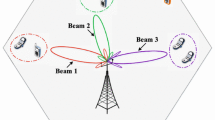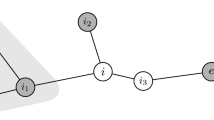Abstract
The capacity gain provided by multiple-input multiple-output (MIMO) systems and network coding has been mainly investigated on an individual basis in the existing literature. The aim of this paper is to analyze the advantaged arising by a combined use of MIMO systems and network coding schemes for unicast and multicast communications under Rayleigh fading propagation conditions. In particular a suitable optimization methodology is proposed here in order to achieve the best performance in terms of mean overall energy consumption and delivery delay. In particular, the advantages of the proposed approach are highlighted for the cases of balanced and unbalanced multicast scenarios on the basis of the average group metric paradigm in order to maximize the average group satisfaction.










Similar content being viewed by others
Notes
This is compliant with the 3GPP long term evolution (LTE) standard.
This means that the channel coefficients do not change during packet duration but change independently from one packet to another.
Optimization process would find infinite transmission power as a trivial solution.
This performance evaluation adopts a BPSK \(4 \times 4\) MRC MIMO communication, with \(B\) = 200 packets.
There is a satisfaction level for every user \(i\) depending on its specific \(\gamma _{0,i}\).
In general \(\alpha _{i}\) values can be derived from service level agreements (SLA) between service provider and single users.
The CSI obtained by transmitter is measured on a single antenna at both transmit and receive sides.
For the sake of readability, it is shown only minimum curves.
References
Ahlswede, R., Cai, N., Li, S. Y., & Yeung, R. (2000). Network information flow. IEEE Transactions on Information Theory, 46(4), 1204–1216.
Digham, F. F., & Alouini, M. S. (2004). Average probability of packet error with diversity reception over arbitrarily correlated fading channels. Wireless Communications and Mobile Computing, 4(2), 155–173.
Driessen, P., & Foschini, G. (1999). On the capacity formula for multiple input-multiple output wireless channels: A geometric interpretation. IEEE Transactions on Communications, 47(2), 173–176.
Eaves, R., & Levesque, A. (1977). Probability of block error for very slow rayleigh fading in gaussian noise. IEEE Transactions on Communications, 25(3), 368–374.
Eryilmaz, A., Ozdaglar, A., Medard, M. (2006). On delay performance gains from network coding. In 40th Annual Conference on Information Sciences and Systems, pp. 864–870.
Fasolo, E., Rossetto, F., Zorzi, M. (2008). Network coding meets mimo. In Fourth Workshop on Network Coding, Theory and Applications, 2008. NetCod, pp. 1–6.
Ge, W., Zhang, J., & Shen, S. (2007). A cross-layer design approach to multicast in wireless networks. IEEE Transactions on Wireless Communications, 6(3), 1063–1071.
Ghaderi, M., Towsley, D., Kurose, J. (2007). Network coding performance for reliable multicast. In IEEE Military Communications Conference. MILCOM 2007, pp. 1–7.
Ghaderi, M., Towsley, D., Kurose, J. (2008). Reliability gain of network coding in lossy wireless networks. In INFOCOM 2008. The 27th Conference on Computer Communications. IEEE, pp. 2171–2179.
Lee, K., & Hanzo, L. (2009). Mimo-assisted hard versus soft decoding-and-forwarding for network coding aided relaying systems. IEEE Transactions on Wireless Communications, 8(1), 376–385.
Lee, N., & Chun, J. (2014). Degrees of freedom for a mimo gaussian k-way relay channel: Successive network code encoding and decoding. IEEE Transactions on Information Theory, 60(3), 1814–1821.
Li, H., Chan, E., & Chen, G. (2010). AEETCadaptive energy-efficient timing control in wireless networks with network coding. Telecommunication Systems, 45(4), 289–301.
Lima, L., Ferreira, D., & Barros, J. (2012). Topology matters in network coding. Telecommunication Systems, 51(4), 247–257.
MacKay, D. (2005). Fountain codes. IEE Proceedings on Communications, 152(6), 1062–1068.
Nguyen, D., Tran, T., Nguyen, T., & Bose, B. (2009a). Wireless broadcast using network coding. IEEE Transactions on Vehicular Technology, 58(2), 914–925.
Nguyen, D., Tran, T., Nguyen, T., & Bose, B. (2009b). Wireless broadcast using network coding. IEEE Transactions on Vehicular Technology, 58(2), 914–925.
Ono, F., Sakaguchi, K. (2008). Space time coded mimo network coding. In IEEE 19th International Symposium on Personal, Indoor and Mobile Radio Communications, PIMRC 2008, pp. 1–5.
Petrovic, I., Stefanovic, M., Spalevic, P., Panic, S., & Stefanovic, D. (2013). Outage analysis of selection diversity over rayleigh fading channels with multiple co-channel interferers. Telecommunication Systems, 52(1), 39–50.
Re, E., Morosi, S., Marabissi, D., Mucchi, L., Pierucci, L., & Ronga, L. (2007). Reconfigurable antenna for future wireless communication systems. Wireless Personal Communications, 42(3), 405–430.
Zhou, R., Li, Z., Wu, C., & Williamson, C. (2013). Signal alignment: Enabling physical layer network coding for mimo networking. IEEE Transactions on Wireless Communications, 12(6), 3012–3023.
Author information
Authors and Affiliations
Corresponding author
Rights and permissions
About this article
Cite this article
Chiti, F., Fantacci, R., Pierucci, L. et al. Optimal joint MIMO and modulation order selection for network coded multicast wireless communications. Telecommun Syst 61, 433–441 (2016). https://doi.org/10.1007/s11235-014-9962-8
Received:
Accepted:
Published:
Issue Date:
DOI: https://doi.org/10.1007/s11235-014-9962-8




